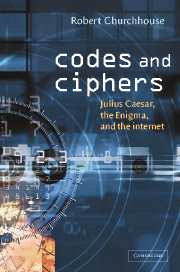Book contents
- Frontmatter
- Contents
- Preface
- 1 Introduction
- 2 From Julius Caesar to simple substitution
- 3 Polyalphabetic systems
- 4 Jigsaw ciphers
- 5 Two-letter ciphers
- 6 Codes
- 7 Ciphers for spies
- 8 Producing random numbers and letters
- 9 The Enigma cipher machine
- 10 The Hagelin cipher machine
- 11 Beyond the Enigma
- 12 Public key cryptography
- 13 Encipherment and the internet
- Appendix
- Solutions to problems
- References
- Name index
- Subject index
9 - The Enigma cipher machine
Published online by Cambridge University Press: 13 August 2009
- Frontmatter
- Contents
- Preface
- 1 Introduction
- 2 From Julius Caesar to simple substitution
- 3 Polyalphabetic systems
- 4 Jigsaw ciphers
- 5 Two-letter ciphers
- 6 Codes
- 7 Ciphers for spies
- 8 Producing random numbers and letters
- 9 The Enigma cipher machine
- 10 The Hagelin cipher machine
- 11 Beyond the Enigma
- 12 Public key cryptography
- 13 Encipherment and the internet
- Appendix
- Solutions to problems
- References
- Name index
- Subject index
Summary
Historical background
In Chapter 2 we looked at simple substitution ciphers and we saw how these can be solved by the use of frequency counts if ‘sufficient’ cipher text is available. How many letters are always ‘sufficient’ is a matter for debate, but it is probably true that 200 letters will normally suffice whereas 50 might not. For our purposes let us assume that if only 25 letters of cipher are available then the cipher is safe. Since a limitation of message lengths to no more than 25 letters would be too restrictive we conclude that the use of a simple substitution cipher is impractical. If, however, we use not one but several different simple substitution alphabets, switching between the alphabets every time we encipher a letter, we can increase the security of the system. As a rough guide: if we use N different alphabets it should be possible to make the cipher safe for single messages of up to 25N cipher letters; but this simple rule needs qualification. If the substitution alphabets are related in some way the recovery of any one of them may lead to recovery of the others. On the other hand, in some systems, additional features may ensure that cipher messages of much greater length than 25N are secure.
- Type
- Chapter
- Information
- Codes and CiphersJulius Caesar, the Enigma, and the Internet, pp. 110 - 132Publisher: Cambridge University PressPrint publication year: 2001



